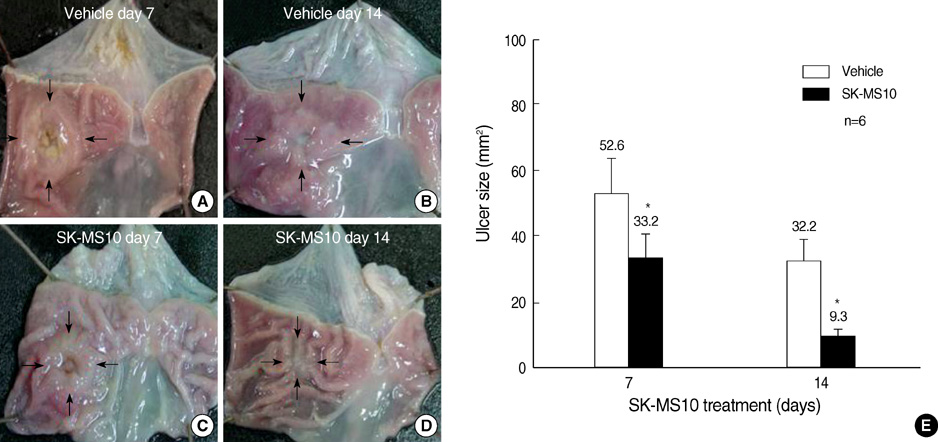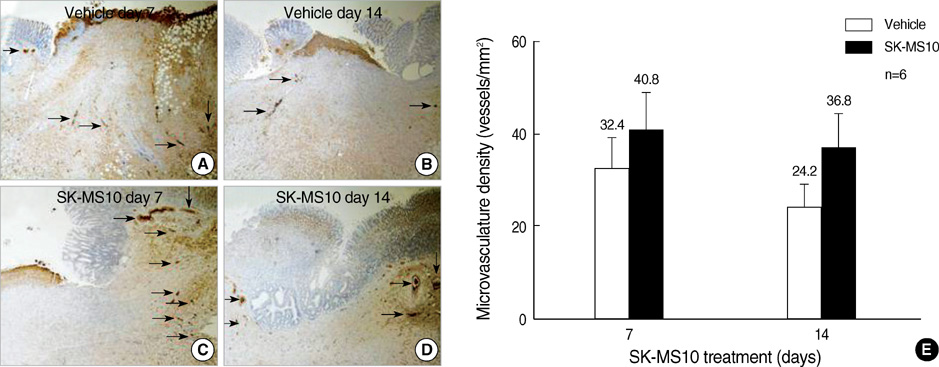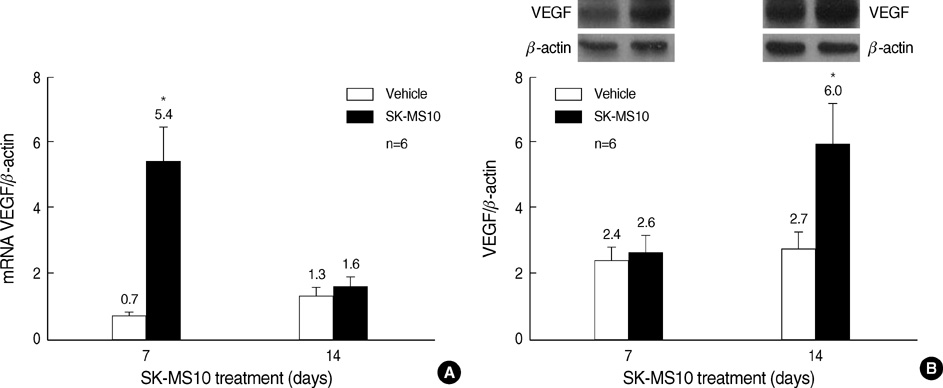J Korean Med Sci.
2010 Jun;25(6):875-881. 10.3346/jkms.2010.25.6.875.
Enhancement of Gastric Ulcer Healing and Angiogenesis by Cochinchina Momordica Seed Extract in Rats
- Affiliations
-
- 1Department of Internal Medicine and Liver Research Institute, Seoul National University College of Medicine, Seoul, Korea.
- 2Department of Internal Medicine, Seoul National University Bundang Hospital, Seongnam, Korea. nayoungkim49@empal.com
- 3Life Science R&D Center, SK Chemicals, Suwon, Korea.
- 4Department of Pathology, Seoul National University Bundang Hospital, Seongnam, Korea.
- KMID: 2150866
- DOI: http://doi.org/10.3346/jkms.2010.25.6.875
Abstract
- Cochinchina momordica seed is the dried ripe seed of Momordica cochinchinensis, a perennial vine. The antiulcer effect of an extract from cochinchina momordica seeds (SK-MS10) was evaluated in a rat model of acetic acid-induced gastric ulcers. Gastric ulcers were produced by subserosal injection of acetic acid. SK-MS10 (200 mg/kg) or vehicle was administered orally once per day for 14 days after the acetic acid injection. The stomach was removed and the ulcer size measured at day 7 and 14 of the treatment. Expression of vascular endothelial growth factor (VEGF) was assessed by real-time RT-PCR and Western blot analysis. In addition, the microvasculature density (MVD) adjacent to the ulcer margin was examined by immunohistochemistry. The treatment with SK-MS10 for 7 and 14 days significantly accelerated ulcer healing and increased the expression of mRNA (at day 7) as well as VEGF protein (at day 14) compared to the vehicle-treated rats. The MVD for factor VIII was also higher in the SK-MS10 treatment group compared to the vehicle-treated rats; however, these differences were not statistically significant. These results suggest that SK-MS10 treatment accelerates the healing of gastric ulcers via upregulation of VEGF and angiogenesis in an acetic acid rat model.
Keyword
Figure
Cited by 1 articles
-
Difficult Establishment of a Chronic Nonsteroidal Anti-inflammatory Drugs Induced Gastric Inflammation Rat Model due to Gastric Adaptation and Small Bowel Damage
Byoung Hwan Lee, Nayoung Kim, Ryoung Hee Nam, Ju Yup Lee, Hye Seung Lee, Chang Hee Lee, Ji Hyun Park, Dong Ho Lee
Korean J Gastroenterol. 2014;63(6):341-347. doi: 10.4166/kjg.2014.63.6.341.
Reference
-
1. Nash J, Lambert L, Deakin M. Histamine H2-receptor antagonists in peptic ulcer disease. Evidence for a prophylactic use. Drugs. 1994. 47:862–871.2. Kim SY, Woo CW, Lee YM, Son BR, Kim JW, Chae HB, Youn SJ, Park SM. Genotyping CagA, VacA subtype, IceA1, and BabA of Helicobacter pylori isolates from Korean patients, and their association with gastroduodenal diseases. J Korean Med Sci. 2001. 16:579–584.3. Ishihara M, Ito M. Influence of aging on gastric ulcer healing activities of cimetidine and omeprazole. Eur J Pharmacol. 2002. 444:209–215.
Article4. Gao XM. Gao XM, editor. Mu Bie Zi (Semen momordicae). Chinese Materia Medicia. 2005. Beijing: Traditional Chinese Materia Medica Press;601–602.5. Kubota K, Sato M, Murakami T, Yamagishi T. Pharmacological studies on the saponin isolated from the seed of Momordica cochinchinensis Sprenger. Yakugaku Zasshi. 1971. 91:174–179.
Article6. Kang JM, Kim N, Kim B, Kim JH, Lee BY, Park JH, Lee MK, Lee HS, Jang IJ, Kim JS, Jung HC, Song IS. Gastroprotective action of cochinchina momordica seed extract is mediated by activation of CGRP and inhibition of cPLA(2)/5-LOX Pathway. Dig Dis Sci. 2009. 54:2549–2560.7. Okabe S, Amagase K. An overview of acetic acid ulcer models--the history and state of the art of peptic ulcer research. Biol Pharm Bull. 2005. 28:1321–1341.8. Okabe S, Pfeiffer CJ. Chronicity of acetic acid ulcer in the rat stomach. Am J Dig Dis. 1972. 17:619–629.
Article9. Takagi K, Okabe S, Saziki R. A new method for the production of chronic gastric ulcer in rats and the effect of several drugs on its healing. Jpn J Pharmacol. 1969. 19:418–426.
Article10. Szabo S, Kusstatscher S, Sakoulas G, Sandor Z, Vincze A, Jadus M. Growth factors: new 'endogenous drugs' for ulcer healing. Scand J Gastroenterol Suppl. 1995. 210:15–18.
Article11. Tarnawski AS. Cellular and molecular mechanisms of gastrointestinal ulcer healing. Dig Dis Sci. 2005. 50:Suppl 1. S24–S33.
Article12. Jo JS, Hong SB, Shin HI, Choi JY. Homologous fibronectin enhances healing of excised wounds in rats. J Korean Med Sci. 1991. 6:197–205.
Article13. Leung DW, Cachianes G, Kuang WJ, Goeddel DV, Ferrara N. Vascular endothelial growth factor is a secreted angiogenic mitogen. Science. 1989. 246:1306–1309.
Article14. Takahashi M, Kawabe T, Ogura K, Maeda S, Mikami Y, Kaneko N, Terano A, Omata M. Expression of vascular endothelial growth factor at the human gastric ulcer margin and in cultured gastric fibroblasts: a new angiogenic factor for gastric ulcer healing. Biochem Biophys Res Commun. 1997. 234:493–498.
Article15. Szabo S, Vincze A, Sandor Z, Jadus M, Gombos Z, Pedram A, Levin E, Hagar J, Iaquinto G. Vascular approach to gastroduodenal ulceration: new studies with endothelins and VEGF. Dig Dis Sci. 1998. 43:9 Suppl. 40S–45S.16. Jones MK, Kawanaka H, Baatar D, Szabo IL, Tsugawa K, Pai R, Koh GY, Kim I, Sarfeh IJ, Tarnawski AS. Gene therapy for gastric ulcers with single local injection of naked DNA encoding VEGF and angiopoietin-1. Gastroenterology. 2001. 121:1040–1047.
Article17. Amagase K, Hayashi S, Nishikawa K, Aihara E, Takeuchi K. Impairment of gastric ulcer healing by alendronate, a nitrogen-containing bisphosphonate, in rats. Dig Dis Sci. 2007. 52:1879–1889.
Article18. Guo JS, Cho CH, Lam Liu ES, Choy HT, Wang JY, Leung Koo MW. Antiangiogenic effect of a highly selective cyclooxygenase-2 inhibitor on gastric ulcer healing in rats. Toxicol Appl Pharmacol. 2002. 183:41–45.
Article19. Amagase K, Yokota M, Tsukimi Y, Okabe S. Characterization of "unhealed gastric ulcers" produced with chronic exposure of acetic acid ulcers to indomethacin in rats. J Physiol Pharmacol. 2003. 54:349–360.20. Kimura Y, Sumiyoshi M, Kawahira K, Sakanaka M. Effects of ginseng saponins isolated from Red Ginseng roots on burn wound healing in mice. Br J Pharmacol. 2006. 148:860–870.
Article21. Tamura K, Sakurai T, Kogo H. Relationship between prostaglandin E2 and vascular endothelial growth factor (VEGF) in angiogenesis in human vascular endothelial cells. Vascul Pharmacol. 2006. 44:411–416.
Article22. Huang B, Ng TB, Fong WP, Wan CC, Yeung HW. Isolation of a trypsin inhibitor with deletion of N-terminal pentapeptide from the seeds of Momordica cochinchinensis, the Chinese drug mubiezhi. Int J Biochem Cell Biol. 1999. 31:707–715.
Article23. Hernandez JF, Gagnon J, Chiche L, Nguyen TM, Andrieu JP, Heitz A, Trinh Hong T, Pham TT, Le Nguyen D. Squash trypsin inhibitors from Momordica cochinchinensis exhibit an atypical macrocyclic structure. Biochemistry. 2000. 39:5722–5730.24. Wong RC, Fong WP, Ng TB. Multiple trypsin inhibitors from Momordica cochinchinensis seeds, the Chinese drug mubiezhi. Peptides. 2004. 25:163–169.
Article25. Tsoi AY, Wong RC, Ng TB, Fong WP. First report on a potato I family chymotrypsin inhibitor from the seeds of a Cucurbitaceous plant, Momordica cochinchinensis. Biol Chem. 2004. 385:185–189.
Article26. Tsoi AY, Ng TB, Fong WP. Antioxidative effect of a chymotrypsin inhibitor from Momordica cochinchinensis (Cucurbitaceae) seeds in a primary rat hepatocyte culture. J Pept Sci. 2005. 11:665–668.27. Ishida BK, Turner C, Chapman MH, McKeon TA. Fatty acid and carotenoid composition of gac (Momordica cochinchinensis Spreng) fruit. J Agric Food Chem. 2004. 52:274–279.28. Gurbuz I, Akyuz C, Yesilada E, Sener B. Anti-ulcerogenic effect of Momordica charantia L. fruits on various ulcer models in rats. J Ethnopharmacol. 2000. 71:77–82.29. Yeo M, Kim DK, Han SU, Lee JE, Kim YB, Cho YK, Kim JH, Cho SW, Hahm KB. Novel action of gastric proton pump inhibitor on suppression of Helicobacter pylori induced angiogenesis. Gut. 2006. 55:26–33.
Article30. Ohno T, Hattori Y, Komine R, Ae T, Mizuguchi S, Arai K, Saeki T, Suzuki T, Hosono K, Hayashi I, Oh-Hashi Y, Kurihara Y, Kurihara H, Amagase K, Okabe S, Saigenji K, Majima M. Roles of calcitonin gene-related peptide in maintenance of gastric mucosal integrity and in enhancement of ulcer healing and angiogenesis. Gastroenterology. 2008. 134:215–225.
Article31. Watanabe T, Higuchi K, Taira K, Sasaki E, Shiba M, Tominaga K, Fujiwara Y, Oshitani N, Arakawa T. Rebamipide reduces delay in gastric ulcer healing in cyclooxygenase-2-deficient mice. Dig Dis Sci. 2005. 50:Suppl 1. S63–S69.
Article32. Weidner N, Semple JP, Welch WR, Folkman J. Tumor angiogenesis and metastasis--correlation in invasive breast carcinoma. N Engl J Med. 1991. 324:1–8.33. Ma L, Chow JY, Wong BC, Cho CH. Role of capsaicin sensory nerves and EGF in the healing of gastric ulcer in rats. Life Sci. 2000. 66:PL213–PL220.
Article34. Lawson DC, Mantyh CR, Pappas TN. Effect of CGRP antagonist, alpha-CGRP 8-37, on acid secretion in the dog. Dig Dis Sci. 1994. 39:1405–1408.35. Harsch IA, Brzozowski T, Bazela K, Konturek SJ, Kukharsky V, Pawlik T, Pawlowski E, Hahn EG, Konturek PC. Impaired gastric ulcer healing in diabetic rats: role of heat shock protein, growth factors, prostaglandins and proinflammatory cytokines. Eur J Pharmacol. 2003. 481:249–260.
Article36. Watanabe T, Higuchi K, Tominaga K, Fujiwara Y, Arakawa T. Acid regulates inflammatory response in a rat model of induction of gastric ulcer recurrence by interleukin 1beta. Gut. 2001. 48:774–781.
Article
- Full Text Links
- Actions
-
Cited
- CITED
-
- Close
- Share
- Similar articles
-
- The Effect of Cochinchina momordica Seed Extract on Gastric Acid Secretion and Morphologic Change in Aged Rat Stomach
- Gastroprotective Effect of Cochinchina momordica Seed Extract in Nonsteroidal Anti-Inflammatory Drug-Induced Acute Gastric Damage in a Rat Model
- Enhancement of Gastric Ulcer Healing and Angiogenesis by Hepatocyte Growth Factor Gene Mediated by Attenuated Salmonella in Rats
- Gastroprotective Effects of Grape Seed Proanthocyanidin Extracts against Nonsteroid Anti-Inflammatory Drug-Induced Gastric Injury in Rats
- Study on the Gastric Cancer Initially Diagnosed as Benign Gastric Ulcer during Endoscopic Follow-up




